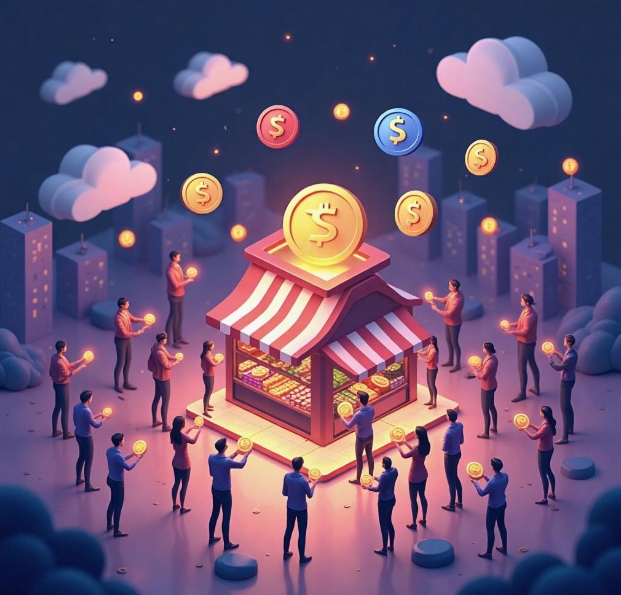How to Enhance User Engagement Through Incentive Mechanisms in DApp Development
- latest articles
- 1.DApp Development & Customization: Merging Diverse Market Needs with User Experience 2.Analysis of the Core Technical System in DApp Project Development 3.How to achieve cross-chain interoperability in Web3 projects? 4.How does the tokenization of points reconstruct the e-commerce ecosystem? 5.How to Set and Track Data Metrics for a Points Mall? 6.What is DApp Development? Core Concepts and Technical Analysis 7.Inventory of commonly used Web3 development tools and usage tips 8.Development of a Distribution System Integrated with Social E-commerce 9.Six Key Steps for Businesses to Build a Points Mall System 10.What is DApp Development? A Comprehensive Guide from Concept to Implementation
- Popular Articles
- 1.Future Trends and Technology Predictions for APP Development in 2025 2.Analysis of the DeFi Ecosystem: How Developers Can Participate in Decentralized Finance Innovation 3.From Zero to One: How PI Mall Revolutionizes the Traditional E-commerce Model 4.DAPP Development | Best Practices for Professional Customization and Rapid Launch 5.Recommended by the Web3 developer community: the most noteworthy forums and resources 6.From Cloud Computing to Computing Power Leasing: Building a Flexible and Scalable Computing Resource Platform 7.How to Develop a Successful Douyin Mini Program: Technical Architecture and Best Practices 8.Shared Bike System APP: The Convenient Choice in the Era of Smart Travel 9.How to Create a Successful Dating App: From Needs Analysis to User Experience Design 10.From Design to Development: The Complete Process of Bringing an APP Idea to Life
With the continuous development of blockchain technology, decentralized applications (DApps) have become an emerging technological trend. DApps utilize blockchain technology for decentralized management, offering transparent, fair, and secure services, with one of their key features being the introduction of incentive mechanisms. As a core component of the DApp ecosystem, incentive mechanisms not only enhance user engagement but also effectively promote the sustainable development of DApps.
This article will explore how to enhance user engagement through incentive mechanisms in DApp development, analyzing aspects such as the concept, evolution, design strategies, and implementation of incentive mechanisms, and providing specific recommendations and practices based on real-world cases.
I. The Relationship Between DApps and Incentive Mechanisms
Before understanding how to enhance user engagement through incentive mechanisms, we first need to clarify the definition of DApps and the meaning of incentive mechanisms.
1.1 Definition of DApps
A DApp (Decentralized Application) is an application that runs on a blockchain network. Unlike traditional applications, DApps achieve decentralization through blockchain technology, with all application data and transaction records stored and managed on the blockchain. This gives DApps advantages such as immutability, transparency, and strong security.
1.2 Definition of Incentive Mechanisms
Incentive mechanisms refer to the use of rewards or penalties to encourage users to engage more actively in DApps. These rewards can include digital currencies, points, tokens, NFTs, etc. Users not only receive immediate rewards for their participation but can also accumulate more value through long-term contributions. In the blockchain world, incentive mechanisms are primarily implemented through smart contracts, ensuring automated, transparent, and fair reward distribution.
II. Goals and Functions of Incentive Mechanisms
In DApps, the core goal of incentive mechanisms is to enhance user engagement and boost ecosystem activity. The role of incentive mechanisms goes beyond increasing user frequency; they also stimulate user creativity and improve collaboration efficiency within the DApp community. Specifically, incentive mechanisms offer the following benefits:
2.1 Attracting New Users
By establishing reasonable incentive mechanisms, DApps can attract new users. For example, users can earn rewards by completing certain tasks or achieving specific milestones, often in the form of valuable tokens or NFTs. This reward system motivates new users to interact more actively upon joining the DApp, effectively increasing the user base.
2.2 Enhancing Engagement of Existing Users
While attracting new users, DApps must also ensure the engagement of existing users. Through continuous reward mechanisms (e.g., regular airdrops, token dividends, level advancements), users' willingness to participate and interaction frequency can be significantly improved. Additionally, long-term incentive mechanisms help maintain user loyalty and reduce churn rates.
2.3 Encouraging Community Contributions
DApp incentive mechanisms are not limited to rewarding user activities; they can also encourage users to contribute to the community. For instance, users can earn rewards by developing DApp plugins, providing technical support, or sharing promotional content. Such mechanisms stimulate user creativity and community spirit, enhancing the value of the DApp ecosystem.
III. Design Strategies for DApp Incentive Mechanisms
To ensure that incentive mechanisms effectively enhance user engagement, DApp developers need to design them from the following perspectives:
3.1 Tokenized Rewards
Tokenized rewards are one of the most common incentive methods in DApps. Tokens, as digital assets with market value, effectively incentivize user participation. DApp developers can design tokenized rewards in the following ways:
Task Rewards: Users receive a certain amount of token rewards after completing specific tasks within the DApp (e.g., registration, transactions, voting).
Participation Dividends: By holding a certain amount of tokens, users can share in the DApp ecosystem's revenue. For example, users holding platform tokens may receive regular dividends or commissions from platform earnings.
Contribution Rewards: Community members receive token rewards based on their contributions, such as publishing content, providing code contributions, or conducting marketing promotions.
The advantage of tokenized rewards lies in their ability to automate distribution through smart contracts. Additionally, as the DApp grows, the value of tokens may increase, attracting more users to join and participate.
3.2 Gamification Mechanisms
Gamification refers to the integration of game design elements into non-game environments to enhance user engagement and a sense of achievement. In DApps, gamification elements can be designed in the following ways:
Tasks and Levels: By designing tasks and levels, users are incentivized to achieve goals step by step, gradually earning rewards. This mechanism increases user time spent on the platform and boosts engagement.
Leaderboards and Competitions: Leaderboards showcase user achievements, enhancing competitiveness and a sense of accomplishment. Users can compete for rewards through contests or events, further increasing participation enthusiasm.
Badges and Achievements: Awarding badges or achievements to users who complete specific tasks increases their sense of honor and social recognition.
Through gamification mechanisms, users not only receive material rewards but also enjoy psychological satisfaction, thereby improving engagement and retention rates.
3.3 Social Incentives
Social incentives enhance user engagement through social interactions. In DApps, social incentives are typically designed in the following ways:
Referral Rewards: Users receive rewards for inviting others to join the DApp platform. This mechanism encourages users to expand the DApp's user base through social networks.
Social Sharing: Users earn additional rewards for sharing their achievements or task completions on the platform, incentivizing them to promote the DApp via social media.
Community Voting and Decision-Making: In decentralized governance DApps, users can earn rewards by participating in voting and decision-making, enhancing their sense of involvement and belonging.
Social incentives make DApps more engaging and leverage the viral effect of social networks to rapidly expand the user base.
IV. Implementation Cases of DApp Incentive Mechanisms
4.1 MakerDAO
MakerDAO is a decentralized stablecoin platform whose incentive mechanisms primarily involve tokenized rewards and participation dividends. Users collateralize crypto assets to obtain the stablecoin Dai and participate in platform governance. The platform regularly distributes token incentives, and users earn revenue dividends by voting on governance decisions to adjust platform parameters.
This incentive mechanism effectively enhances user engagement and platform stability while encouraging active participation in governance and development.
4.2 Steemit
Steemit is a blockchain-based social media platform whose incentive mechanisms primarily reward users for content creation and social interactions. Users earn rewards for articles and comments based on community votes. Steemit uses this approach to incentivize high-quality content creation and interaction, maintaining platform activity.
Steemit's success demonstrates that social incentives can significantly boost user creativity and improve content quality on the platform.
V. Conclusion
By designing incentive mechanisms appropriately, DApps can effectively enhance user engagement, increase activity, and promote community building and development. In DApp incentive design, tokenized rewards, gamification mechanisms, and social incentives are common and effective strategies. By learning from successful cases and flexibly applying these incentive methods, DApp developers can create a more attractive and vibrant decentralized ecosystem.
In the future, with continuous technological innovation and optimization of incentive mechanisms, user engagement in DApps will further increase, and the application prospects of blockchain will become even broader.
-

DApp Development & Customization: Merging Diverse Market Needs with User Experience
As blockchain technology matures and becomes more widespread, decentralized appl···
-

Analysis of the Core Technical System in DApp Project Development
With the rapid development of blockchain technology, decentralized applications ···
-

What is DApp Development? Core Concepts and Technical Analysis
With the rapid development of blockchain technology, decentralized applications ···

 Blockchain
Blockchain












